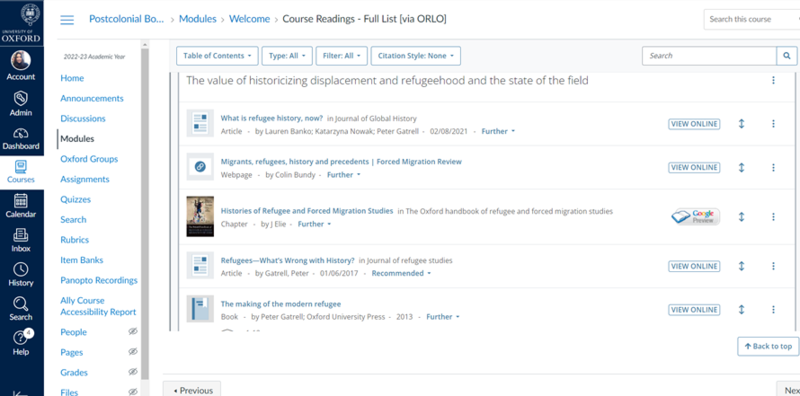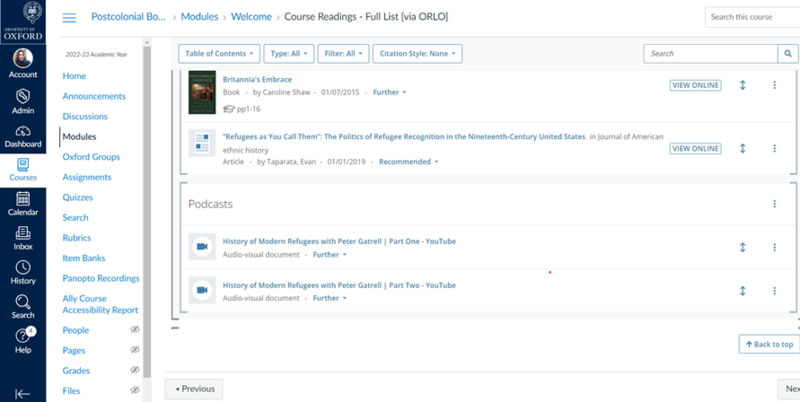- Group size: 15 students
- Teaching type: Postgraduate
- Division: Social Sciences
- Subject: Postcolonial Borders and Forced Migration
- Tools: ORLO, Panopto, Canvas
Delivery
This case study details how Dr Uttara Shahani organised her history course Postcolonial Borders and Forced Migration using digital resources such as ORLO, Panopto and Canvas for inclusive teaching. She planned the course using the base structured in Canvas from the previous tutor, who included resources such as podcasts in her reading lists. As she thought this structure could work effectively with her students, Dr Shahani decided to organise the reading list in ORLO using books, articles, and audio-visual resources such as documentaries, podcasts, and YouTube. For this process, the help of her Local Canvas Coordinator (LCC) Andrea Smith was essential, as she supported her with building up the basic ORLO list. Dr Shahani has continued to add primary and secondary sources in different formats as the course has progressed.

Figure 1. This figure shows an example of the ORLO reading list from the Postcolonial Borders and Forced Migration course
Strengths
In terms of what motivated Dr Shahani to organise her module using an inclusive approach, she explains: ‘my rationale for incorporating strategies that support students’ learning process stems from the fact that I learned about the importance of inclusive and accessible instruction when I was part of a Teaching and Learning Programme at the Centre for Teaching and Learning. This forced me to think beyond textual sources.’ Therefore, when selecting resources to apply in her own course, she realised that select podcasts with historians were ‘a useful way for students to deepen their knowledge around the subject matter’ (Postcolonial Borders and Forced Migration). Furthermore, Dr Shahani states that the students have included what they have learned in the podcasts in their essays, which she thinks ‘makes this material a viable source for teaching and learning in addition to books and articles.’ As this is a history course, students also benefit from the use of a variety of visual materials such as maps and paintings.

Figure 2. This image shows the integration of podcast into the ORLO reading list of the course
Limitations
Dr Shahani highlights the integration of audio-visual materials into seminars, so they can be added into face-to-face instruction. She has complemented her teaching with Panopto recordings and hybrid seminar sessions to maximise the integration of different resources. This has been helpful for students who at times cannot attend in-person classes but challenging at the same time in terms of technical issues. Despite this, Dr Shahani will continue to use different digital resources to support her teaching.
Summary
The students' feedback on this organisation of the reading list and seminar sessions in the Postcolonial Borders and Forced Migration course has been overall positive as they have been able to better engage with the content of the subject. They also find the recorded lectures useful. They have indicated that they find the volume of reading material to be sometimes overwhelming. In the future, Dr Shahani expects to continue optimising the ORLO reading list to find a balance between traditional learning sources such as books and articles and using inclusive digital resources to support her students.
Contributed by: Dr Uttara Shahani, Departmental Lecturer in Forced Migration, Department of International Development